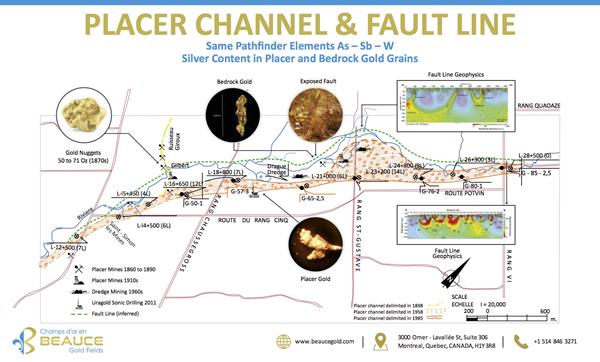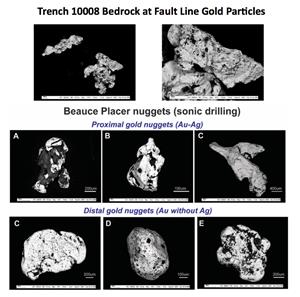MONTREAL, March 02, 2020 — Beauce Gold Fields (Champs D’Or en Beauce) (BGF) (TSX Venture: ¨BGF¨) is pleased to announce that a comparative analysis of both gold particles and of bedrock geochemistry samples taken from the exposed geological Fault Line at Poulin Trench 10008 (press release February 3rd 2020) link the proposed Fault Line to the historical placer gold channel found on the Company’s St-Simon-Les-Mines property.
Geochemistry analysis show a strong correlation of pathfinder elements: arsenic, tungsten, and antimony. Moreover, SEM analyses indicate similar silver content in bedrock gold particles to the placer channel gold nuggets.
This gives full weight to the theory that the fault zone could be the host of an ancient hydrothermal gold system.
Patrick Levasseur, president, and CEO of Beauce Gold Fields said,
“The match in pathfinders elements, as well as a match in silver to gold content, is the strongest evidence yet associating bedrock gold at the geological fault line to the historical placer channel.” Mr. Levasseur further stated: “This gives full weight to the theory that the fault zone could be the host of an ancient hydrothermal gold system responsible for the concentration of gold in the rock. The presence of this gold system could explain, among other things, the gold placers found in the basal till and the underlying saprolite along the historic Saint-Simon-Les-Mines placer gold channel. We believe that focusing on this system could lead to new gold discoveries”

Map: Saint-Simon les Mines Placer Channel and Fault Line
Silver Content Of Bedrock Gold Particles Similar To Placer Channel Gold Nuggets
In Company’s February 3rd 2020 press release, it was reported that samples taken from Poulin trench 10008 contained three visible gold particles totaling 0.55 mg (0.275 g/t). The particles were extracted from volcaniclastic rocks that were heavily injected with rusty quartz veins. The excavation of trench 10008 also exposed the main geological Fault Line that runs along strike the historical placer gold channel on the Company’s St-Simon-Les-Mines property.
In March of 2011, the Company’s former parent company, HPQ Silicon Resources (formerly known as Uragold), completed a Sonic Drill program into the historical placer gold channel. Eighteen (18) coarse gold grains and nuggets were extracted from cores of auriferous basal till and saprolite. (Source: Beauce Gold Fields’ compliant NI-43-101 Technical Report July 4th 2018)
Under the supervision of Dr. Marc Richer-LaFlèche, Ph.D. Géo from INRS, the 3 Fault zone Poulin trench 10008 gold particles and the eighteen of the 2011 Sonic Drilled gold grains were sent to INRS and analyzed using a Zeiss EVO® 50 smart SEM (SEM) scanning electron microscope coupled to an Oxford Instruments elementary microanalysis system by X-ray energy dispersion spectrometry (EDS). For the Poulin trench gold particles, 41 of the 62 random sequenced analysis over the scanned particles revealed a silver content that ranged between 2.71% Ag to 8.14% Ag with an average reading of 6.03% Ag.
For comparative analysis, morphology of the auriferous basal till and saprolite gold grains were separated into groups of proximal angular vs distal rounded shapes. It was observed that relatively angular nuggets (example A, B and C) contain an average Au-Ag mixture of 6.80% Ag (Silver) (25 random sequenced analysis ranging 1.26% to 21.30% Ag) which is similar to the gold observe in Trench-10008. Some nuggets have internal cavities filled with iron oxides (goethite-hematite) probably reflecting the saprolitisation (weathering) of bedrock and of little hydraulic transportation. The second population of nuggets (example C, D and E) were rounded by hydraulic transport, and which do not contain silver (only gold). It is likely that these nuggets of almost pure gold were affected by geochemical or biogeochemical process involving preferential leaching of silver. Note that in the St-Simon-les-Mines area, the presence of saprolitized rocks is a local geological characteristic essentially observed in the sector of the Beauce placer near the Gilbert river (including rocks from the 10008 trench and outcrop 8000). Such weathered rocks are not preserved elsewhere in the study area. The presence of gold nuggets showing internal weathering embayments rich in iron oxides is another evidence suggesting a local provenance of gold.
In August of 2013, Uragold analyzed gold nuggets collected from material presumed to have been processed by the previous 1960s gold dredging operation. The gold nuggets were identified as having a silver content of 10%. In 1987, a study of placer gold nuggets by Coniagas Mines revealed a silver content of 7-8% Ag. (Source: Beauce Gold Fields’ compliant NI-43-101 Techical Report July 4th 2018)
The Company’s July 4th 2018 43-101 Report states that analysis of the silver content and of the gold particle shapes of historical gold nuggets suggest they are detrital in origin and that they have undergone only minor transport. Meaning that the nuggets from the placer channel are derived from pre-existing rock that, through processes of weathering formed the saprolite rock that in turn eroded to form the basal till. The similarities in the silver content of Poulin Trench bedrock gold particles with that of historical placer gold nuggets indicated a shared origin.
| Gold Location | Nugget Shape | Silver Content |
| Bedrock at Fault Line | angular | 6.03% |
| Saprolite, Placer Channel | angular | 6.80% |
| Basal Till, Placer Channel | rounded | No Silver |

SEM images of gold particles and nuggets
Pathfinder Elements Indicate A Link Between Bedrock At Fault Line To The Historical Placer Gold Channel
The Company’s July 4th 2018 43-101 report states that analysis of dense mineral concentrate of basal till and saprolite drilled from the historical placer gold channel revealed pathfinders elements of arsenic, tungsten and antimonyup to 135 ppm As, 580 ppm W and 8 ppm Sb.
In 2019, The Company collected 267 channel samples from rock outcrops and trenches throughout an area of 30 square kilometers centered around the St-Simon-les-Mines historical placer gold district. Out of 267 samples, only sample #8000 and sample TR 10008 contained the full suite of pathfinder elements of arsenic, tungsten and antimony. Sample TR 10008 was taken from Poulin Trench 10008. As noted above, Trench 10008 contained visible gold particles from bedrock and exposed the main geological fault line that runs along the historical placer gold channel. Sample #8000 was from an outcrop to NE to Trench 10008.
Geochemical association of pathfinder elements and silver in gold nuggets is the strongest evidence yet that gives weight to the theory that the fault zone could be the host of an ancient hydrothermal gold system responsible for the concentration of gold in the rock. The presence of this gold system could explain, among other things, the gold placers found in the basal till and the underlying saprolite along the historic Saint-Simon-les-Mines placer gold channel.
Channel Sample Highlights include
- 3 channel Samples #5051 B, B2 and C: Taken from an outcrop along St-Charles Road returned anomalous gold values of 70, 98, 560 ppb Au. Potentially identifying a new gold zone North West of the property.
- Sample #8000: 25 ppb Au, pathfinders 245 ppm As, 0.7 ppm Sb, 2 ppm W
- Samples TR 10008 A, B & C pathfinders (29 to 75 ppm of As, 0.7 to 1 ppm of Sb, 4 to 8 ppm of W)
- Sample 6007-b: 124 bbp Au. Quartz veined rock outcrop on eastern bank of Ruisseau Giroux in the area surrounded by 19th century placer gold mining shafts.
- Balance of channeled outcrop samples throughout 30sq km returned no significant gold values. This narrows down the exploration area for a hard rock gold deposit along the Fault Line and Ruisseau Giroux.
The exploration team, under the supervision of Dr. Marc Richer-LaFleche, Ph.D. Géo of INRS, systematically prospected, sampled and mapped the main outcrops, located on both sides of Gilbert River and Giroux Creek, more specifically between Rang St-Charles and Rang VI roads. The geological mapping and structural geology work was aimed at documenting and to gain a better understanding the geochemistry of the area’s sedimentary and volcanic rocks. Special attention was paid to sampling the different generations of quartz veins in the region. 267 channel and bulk samples were collected, prepared and sent to Activation Labs (Ancaster, Ontario) assayed for gold and other trace elements.
Marc Richer-LaFlèche, Ph.D. Geo., a qualified person as defined by NI 43-101, has reviewed and approved the technical information presented in this release.
—
About Beauce Gold Fields
Beauce Gold Fields is a gold exploration company focused on placer to hard rock exploration in the Beauce region of Southern Quebec. The Company’s flagship property is the St-Simon-Les-Mines Gold project site of Canada’s first gold rush which pre-dates the Yukon Klondike. The Beauce region hosted some of the largest historical placer gold mines in Eastern North America that were active from the 1860s to the 1960s It produced some of the largest gold nuggets in Canadian mining history (50oz to 71oz)
Comprising 152 contiguous claims and 7 real estate lots, the project area contains a six-kilometer long placer channel consisting of unconsolidated gold-bearing auriferous units of a lower saprolite and an upper brown diamictite. The Company has calculated a Gold Exploration Target for the entire historical placer channel ranges between 61,000 ounces (2,200,000 m3 @ 0.87g Au/m3) and 366,000 ounces* (2,200,000 m3 @ 5.22 g Au/m3). Source: Beauce July 4th, 2018[43-101 Report.
The Company has identified a major Fault Line that coincides with an interpreted fault structure across the property. Evidence suggests the erosion of the Fault Line as a probable source of the historical placer gold channel.
Disclaimers:
This press release contains certain forward-looking statements, including, without limitation, statements containing the words “may”, “plan”, “will”, “estimate”, “continue”, “anticipate”, “intend”, “expect”, “in the process” and other similar expressions which constitute “forward-looking information” within the meaning of applicable securities laws. Forward-looking statements reflect the Company’s current expectation and assumptions, and are subject to a number of risks and uncertainties that could cause actual results to differ materially from those anticipated. These forward-looking statements involve risks and uncertainties including, but not limited to, our expectations regarding mineral exploration. Such statements reflect the current views of the Company with respect to future events and are subject to certain risks and uncertainties and other risks detailed from time-to-time in the Company’s on-going filings with the securities regulatory authorities, which filings can be found at www.sedar.com. Actual results, events, and performance may differ materially. Readers are cautioned not to place undue reliance on these forward-looking statements. The Company undertakes no obligation to publicly update or revise any forward-looking statements either as a result of new information, future events or otherwise, except as required by applicable securities laws.
Neither the TSX Venture Exchange nor its Regulation Services Provider (as that term is defined in the policies of the TSX Venture Exchange) accepts responsibility for the adequacy or accuracy of this release.
For further information contact
Patrick Levasseur, President and CEO Tel: (514) 262-9239
Bernard J. Tourillon, Chairman and COO Tel (514) 907-1011
www.beaucegold.com

Beauce Gold Fields is a gold exploration company focused on placer to hard rock exploration in the Beauce region of Southern Quebec.


